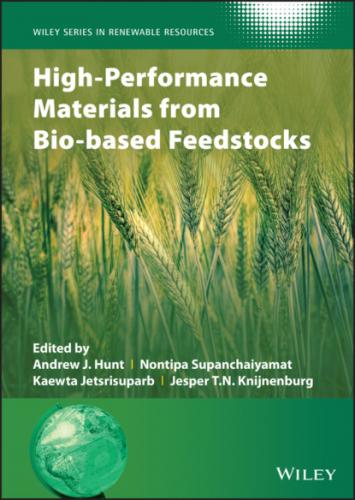The next two chapters make a transition toward inorganic materials. Chapter 12 discusses the green synthesis of bio‐based MOFs and the wide range of applications. Applications of geopolymers prepared from biomass ashes with applications in the construction industry are presented in Chapter 13.
Finally, the last three chapters present the use of bio‐based materials in food, packaging, and fertilizers. Chapter 14 highlights the use of various bio‐based materials as functional ingredients used in the formulation of lipophilic nutraceuticals. Key developments on the role of bio‐based materials in emulsions, colloidal delivery vehicles, as well as in drying technologies are reviewed. The use of bio‐based materials like polysaccharides and bio‐derived polymers in advanced packaging materials is discussed in Chapter 15. Finally, Chapter 16 presents the recent developments in controlled fertilizer applications using bio‐based materials such as polysaccharides, alkyd resins, polyurethanes, and biochars.
References
1 1. Munier, N. (2005). Introduction to Sustainability: Road to a Better Future. Dordrecht: Springer.
2 2. Blewitt, J. (2008). Understanding Sustainable Development. Padstow: Earthscan.
3 3. United Nations World Commission on Environment and Development (1987). Our Common Futute (Brundtland Report). Oxford: Oxford University Press.
4 4. The United Nations (1993). Report of the United Nations Conference on Environment and Development. New York: United Nations.
5 5. Schummer, J., Bensaude‐Vincent, B., and Van Tiggelen, B. (2007). The Public Image of Chemistry. Singapore: World Scientific Publishing.
6 6. Anastas, P.T. and Warner, J.C. (1998). Green Chemistry: Theory and Practice. New York: Oxford University Press.
7 7. Curran, M.A. (2010). Biobased materials. In: Kirk‐Othmer Encyclopedia of Chemical Technology (ed. C. Ley), 1–19. Hoboken, NJ: Wiley.
8 8. Taherzadeh, M., Bolton, K., Wong, J., and Pandey, A. (2019). Sustainable Resource Recovery and Zero Waste Approaches. Elsevier.
9 9. Babu, R.P., O'connor, K., and Seeram, R. (2013). Current progress on bio‐based polymers and their future trends. Progress in Biomaterials 2 (1): 1–16.
10 10. Smith, E.L., Abbott, A.P., and Ryder, K.S. (2014). Deep eutectic solvents (DESs) and their applications. Chemical Reviews 114 (21): 11060–11082.
11 11. Supanchaiyamat, N., Jetsrisuparb, K., Knijnenburg, J.T.N. et al. (2019). Lignin materials for adsorption: current trend, perspectives and opportunities. Bioresource Technology 272: 570–581.
12 12. Ragauskas, A.J., Williams, C.K., Davison, B.H. et al. (2006). The path forward for biofuels and biomaterials. Science 311 (5760): 484–489.
13 13. Hamad, K., Kaseem, M., Ayyoob, M. et al. (2018). Polylactic acid blends: the future of green, light and tough. Progress in Polymer Science 85: 83–127.
14 14. González‐García, P. (2018). Activated carbon from lignocellulosics precursors: a review of the synthesis methods, characterization techniques and applications. Renewable and Sustainable Energy Reviews 82: 1393–1414.
15 15. Sim, D.H.H., Tan, I.A.W., Lim, L.L.P., and Hameed, B.H. (2021). Encapsulated biochar‐based sustained release fertilizer for precision agriculture: a review. Journal of Cleaner Production 303, 127018.
16 16. Xiong, X., Yu, I.K.M., Cao, L. et al. (2017). A review of biochar‐based catalysts for chemical synthesis, biofuel production, and pollution control. Bioresource Technology 246: 254–270.
17 17. Thommes, M., Kaneko, K., Neimark, A.V. et al. (2015). Physisorption of gases, with special reference to the evaluation of surface area and pore size distribution (IUPAC Technical Report). Pure and Applied Chemistry 87 (9–10): 1051–1069.
18 18. Stein, A., Wang, Z., and Fierke, M.A. (2009). Functionalization of porous carbon materials with designed pore architecture. Advanced Materials 21 (3): 265–293.
19 19. Zhu, J., Yan, C., Zhang, X. et al. (2020). A sustainable platform of lignin: from bioresources to materials and their applications in rechargeable batteries and supercapacitors. Progress in Energy and Combustion Science 76: 100788.
20 20. Vassilev, S.V., Baxter, D., Andersen, L.K., and Vassileva, C.G. (2013). An overview of the composition and application of biomass ash. Part 1. Phase‐mineral and chemical composition and classification. Fuel 105: 40–76.
21 21. Zając, G., Szyszlak‐Bargłowicz, J., Gołębiowski, W., and Szczepanik, M. (2018). Chemical characteristics of biomass ashes. Energies 11 (11): 2885.
22 22. Pode, R. (2016). Potential applications of rice husk ash waste from rice husk biomass power plant. Renewable and Sustainable Energy Reviews 53: 1468–1485.
23 23. Goutam, S., Omar, N., Van Den Bossche, P., and Van Mierlo, J. (2017). Review of nanotechnology for anode materials in batteries. In: Emerging Nanotechnologies in Rechargeable Energy Storage Systems (ed. L.M. Rodriguez‐Martinez and N. Omar), 45–82. Elsevier.
24 24. Thomas, B.S., Yang, J., Mo, K.H. et al. (2021). Biomass ashes from agricultural wastes as supplementary cementitious materials or aggregate replacement in cement/geopolymer concrete: a comprehensive review. Journal of Building Engineering 40: 1–12.
2 Bio‐based Carbon Materials for Catalysis
Chaiyan Chaiya and Sasiradee Jantasee
Department of Chemical Engineering and Materials, Rajamangala University of Technology Thanyaburi, Pathum Thani, Thailand
2.1 Introduction
Developments of inexpensive heterogeneous catalysts to replace conventional homogeneous catalysts for extensive applications are currently investigated by many research studies. Inorganic materials such as silica (SiO2), alumina (Al2O3), zirconia (ZrO2), titania (TiO2), magnesium oxide (MgO), zeolite, and clays have received much attention for their use in catalysis [1]. Carbon‐based catalysts are among the promising heterogeneous catalysts used in a wide range of applications, which can be derived from both inorganic and organic resources. These materials have high stability in several reaction media and highly versatile chemical and physical properties. A great number of attempts have been made to synthesize carbon‐based materials from various raw biomasses and biomass‐derived compounds such as agricultural products
